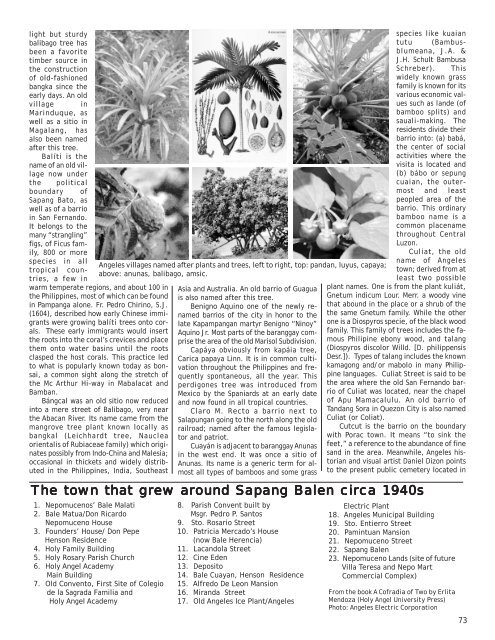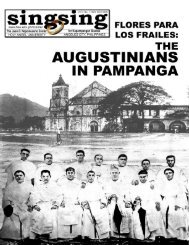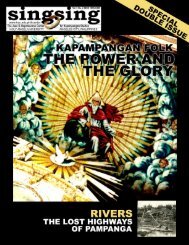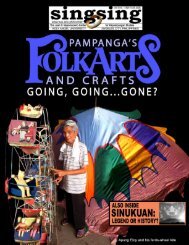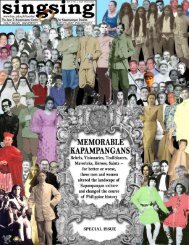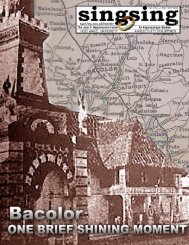Download PDF - Holy Angel University
Download PDF - Holy Angel University
Download PDF - Holy Angel University
You also want an ePaper? Increase the reach of your titles
YUMPU automatically turns print PDFs into web optimized ePapers that Google loves.
light but sturdy<br />
balibago tree has<br />
been a favorite<br />
timber source in<br />
the construction<br />
of old-fashioned<br />
bangka since the<br />
early days. An old<br />
village in<br />
Marinduque, as<br />
well as a sitio in<br />
Magalang, has<br />
also been named<br />
after this tree.<br />
Balíti is the<br />
name of an old village<br />
now under<br />
the political<br />
boundary of<br />
Sapang Bato, as<br />
well as of a barrio<br />
in San Fernando.<br />
It belongs to the<br />
many “strangling”<br />
figs, of Ficus family,<br />
800 or more<br />
species in all<br />
tropical countries,<br />
a few in<br />
warm temperate regions, and about 100 in<br />
the Philippines, most of which can be found<br />
in Pampanga alone. Fr. Pedro Chirino, S.J.<br />
(1604), described how early Chinese immigrants<br />
were growing balíti trees onto corals.<br />
These early immigrants would insert<br />
the roots into the coral’s crevices and place<br />
them onto water basins until the roots<br />
clasped the host corals. This practice led<br />
to what is popularly known today as bonsai,<br />
a common sight along the stretch of<br />
the Mc Arthur Hi-way in Mabalacat and<br />
Bamban.<br />
Bángcal was an old sitio now reduced<br />
into a mere street of Balibago, very near<br />
the Abacan River. Its name came from the<br />
mangrove tree plant known locally as<br />
bangkal (Leichhardt tree, Nauclea<br />
orientalis of Rubiaceae family) which originates<br />
possibly from Indo-China and Malesia;<br />
occasional in thickets and widely distributed<br />
in the Philippines, India, Southeast<br />
<strong>Angel</strong>es villages named after plants and trees, left to right, top: pandan, luyus, capaya;<br />
above: anunas, balibago, amsic.<br />
1. Nepomucenos’ Bale Malati<br />
2. Bale Matua/Don Ricardo<br />
Nepomuceno House<br />
3. Founders’ House/ Don Pepe<br />
Henson Residence<br />
4. <strong>Holy</strong> Family Building<br />
5. <strong>Holy</strong> Rosary Parish Church<br />
6. <strong>Holy</strong> <strong>Angel</strong> Academy<br />
Main Building<br />
7. Old Convento, First Site of Colegio<br />
de la Sagrada Familia and<br />
<strong>Holy</strong> <strong>Angel</strong> Academy<br />
Asia and Australia. An old barrio of Guagua<br />
is also named after this tree.<br />
Benigno Aquino one of the newly renamed<br />
barrios of the city in honor to the<br />
late Kapampangan martyr Benigno “Ninoy”<br />
Aquino Jr. Most parts of the baranggay comprise<br />
the area of the old Marisol Subdivision.<br />
Capáya obviously from kapáia tree,<br />
Carica papaya Linn. It is in common cultivation<br />
throughout the Philippines and frequently<br />
spontaneous, all the year. This<br />
perdigones tree was introduced from<br />
Mexico by the Spaniards at an early date<br />
and now found in all tropical countries.<br />
Claro M. Recto a barrio next to<br />
Salapungan going to the north along the old<br />
railroad; named after the famous legislator<br />
and patriot.<br />
Cuayán is adjacent to baranggay Anunas<br />
in the west end. It was once a sitio of<br />
Anunas. Its name is a generic term for almost<br />
all types of bamboos and some grass<br />
8. Parish Convent built by<br />
Msgr. Pedro P. Santos<br />
9. Sto. Rosario Street<br />
10. Patricia Mercado’s House<br />
(now Bale Herencia)<br />
11. Lacandola Street<br />
12. Cine Eden<br />
13. Deposito<br />
14. Bale Cuayan, Henson Residence<br />
15. Alfredo De Leon Mansion<br />
16. Miranda Street<br />
17. Old <strong>Angel</strong>es Ice Plant/<strong>Angel</strong>es<br />
species like kuaian<br />
tutu (Bambusblumeana,<br />
J.A. &<br />
J.H. Schult Bambusa<br />
Schreber). This<br />
widely known grass<br />
family is known for its<br />
various economic values<br />
such as lande (of<br />
bamboo splits) and<br />
sauali-making. The<br />
residents divide their<br />
barrio into: (a) babá,<br />
the center of social<br />
activities where the<br />
visita is located and<br />
(b) bábo or sepung<br />
cuaian, the outermost<br />
and least<br />
peopled area of the<br />
barrio. This ordinary<br />
bamboo name is a<br />
common placename<br />
throughout Central<br />
Luzon.<br />
Culiat, the old<br />
name of <strong>Angel</strong>es<br />
town; derived from at<br />
least two possible<br />
plant names. One is from the plant kuliát,<br />
Gnetum indicum Lour. Merr. a woody vine<br />
that abound in the place or a shrub of the<br />
the same Gnetum family. While the other<br />
one is a Diospyros specie, of the black wood<br />
family. This family of trees includes the famous<br />
Philipine ebony wood, and talang<br />
(Diospyros discolor Willd. [D. philippensis<br />
Desr.]). Types of talang includes the known<br />
kamagong and/or mabolo in many Philippine<br />
languages. Culiat Street is said to be<br />
the area where the old San Fernando barrio<br />
of Culiat was located, near the chapel<br />
of Apu Mamacalulu. An old barrio of<br />
Tandang Sora in Quezon City is also named<br />
Culiat (or Coliat).<br />
Cutcut is the barrio on the boundary<br />
with Porac town. It means “to sink the<br />
feet,” a reference to the abundance of fine<br />
sand in the area. Meanwhile, <strong>Angel</strong>es historian<br />
and visual artist Daniel Dizon points<br />
to the present public cemetery located in<br />
The he to town to wn tha that tha t g ggrew<br />
g w ar around ar ar ound Sa Sapang Sa pang Balen Balen cir circa cir cir ca 1940s 1940s<br />
1940s<br />
Electric Plant<br />
18. <strong>Angel</strong>es Municipal Building<br />
19. Sto. Entierro Street<br />
20. Pamintuan Mansion<br />
21. Nepomuceno Street<br />
22. Sapang Balen<br />
23. Nepomuceno Lands (site of future<br />
Villa Teresa and Nepo Mart<br />
Commercial Complex)<br />
From the book A Cofradia of Two by Erlita<br />
Mendoza (<strong>Holy</strong> <strong>Angel</strong> <strong>University</strong> Press)<br />
Photo: <strong>Angel</strong>es Electric Corporation<br />
73


